Alfa Romeo Rides Exotic 4C Back Into U.S.
By John Gilbert
Every auto manufacturer wants to convince customers that its cars are fun, and exciting to drive. Then there are the Italians. Say no more. There is never a need for an Italian car-maker to suggest that his car is emotional, or exciting. It comes with the territory.
That’s the backdrop for the Alfa Romeo 4C, which Alfa Romeo plans to ride back into the U.S. auto market for 2015. We can call it a $55,000 thrill-making toy, and that’s not a rip. That’s basically what a Corvette Sting Ray is, or a Porsche Boxster S or Cayman S, or a Nissan GTR or 370Z. All are fun, and describe the genre, and all cost substantially more than $55,000. When you build a specialty sports car, you can charge a lot, but you’d better back it up with substance.
The 4C has, for substance: mid-engine balance, an extremely light (2,400-pound) mass that can be hurled 0-60 in the mid-4-second range, a top speed of 160 mph, an over-achieving aluminum 1,750 cc. turbocharged and direct-injected 4-cylinder, light and precise suspension and steering, and a high-tech body that owes its construction and heritage to contemporary Formula 1 technology.
The look and the performance rank in the exotic supercar class, but if that’s not enough, Alfa is going to build in an exclusivity. Only 1,000 Alfa Romeo 4C cars will be distributed to anxious U.S. buyers in its first year, through selected Fiat dealerships. One of the 4C models I drove listed for $58,295 with racing exhaust and bi-xenon headlights.

Race track setting proves designer Lorenzo Ramaciotti brought the 4C contours and emotional flair all together.
If you’re unconvinced that the 4C is emotional, and fun to drive, standing next to one is pretty good evidence of the former and starting the engine is convincing of the latter. The sound is exhilarating. It resembles the “sports-plus” settings for straight-through exhausts on Porsches or the new Corvette. The sound is part of the overall image, but it’s best experienced somewhere like the road-racing circuit at Sonoma, California, which used to be known as Sears Point.
Shift the twin-clutch direct-sequential gearbox into first and pull out of the pit lane. The steering feels just a bit heavy at first, but that’s because Alfa chose not to waste any energy on power steering. Once rolling, the light-front 4C steering is perfect, as is its precision. Build a little speed, as you exit the pits, and ease slightly up the slope toward Turn 1. Hammer it, and the sound gets better, and its reflexes seem to improve as well. The fantastic responses of the car react to every tiny steering, curving, braking or accelerating input you choose, and they conspire to create a sensory deadlock: It is impossible to calculate which is the best characteristic of just how emotional and exciting the Alfa 4C is.
After first seeing the 4C at a couple of big auto shows, I couldn’t wait to fold myself inside one for a test drive. The time presented itself when I was invited to join a group of eager journalists who drove a fleet of Alfas from our hotel in San Francisco up to Sonoma’s road-racing track. The car will be made in six exterior colors altogether — black, basalt grey metallic, a milky eye-catcher called “Madreperla White Tri-coat,” and my favorite two — Rosso Alfa, and Rosso Competizione Tri-coat.
I had fun asking other journalists which red they preferred, but instead of calling them “Rosso Competizione Tri-coat,” a very metallic red, or the nonmetallic “Rosso Alfa,” I merely pointed at the two parked side by side. Most chose the metallic, but it deserved a pause. Every company makes an impressive metallic red, but only a precious few — most notably Ferrari, Porsche, and Alfa Romeo — cover a car with a pure, deep, flat red that electrifies you more the longer you gaze at it. So that’s my pick, and it has nothing to do with how many thousands of dollars you might save avoiding the metallic if you ever had to touch up a nick or scratch.
If you are old enough to remember the movie “The Graduate,” you remember it as a cleverly written classic that starred Dustin Hoffman as a college-age kid, co-starring with an Alfa Romeo roadster, which became known thereafter as the Graduate. Alfa Romeo brought some other fine cars to the U.S. back then, including the GTB, a sleek fastback coupe of the late 1960s that allowed Horst Kwech to battle John Morton’s factory Datsun 510 for the Under-2.5-liter road-racing championship. Alfa won two titles, the second in 1970. Years later, after also bringing in a stylish 164 sedan, Alfa pulled out of the U.S. market, as did other European manufacturers, including Fiat.
Nowadays, Fiat is an enormous conglomerate, owning Ferrari, Alfa, Lancia, and Chrysler along with its namesake. And it’s time to come back into the U.S. Fiat, which has done an excellent job of changing the entire culture of Chrysler Group — including Dodge, Ram and Jeep — promotes its own fun little Fiat 500 subcompact, and is right on schedule to bring long-deprived U.S. drivers a taste of Italian sports-car flair, all part of a larger picture.
Lorenzo Ramaciotti, who is the head of design for Fiat and Chrysler, and who used to work for the reknown Italian coach-maker Pininfarina, was asked to back away from the justifiable celebration of the 4C and tell me what his next project would be. “The next Alfa for the U.S.,” he said. “We have a five-year plan for bringing in eight Alfa models to the U.S.” After the 4C, I can’t even imagine what directions Alfa intends to go with its new models. I asked Ramaciotti what was his favorite personal design ever.
“I couldn’t name my favorite, or my favorite three, or list the top 10,” he said. When I pressed him, he explained that for Pininfarina, he designed the Ferrari 456GT, which might be why he can’t compare others, and he has drawn everything from such six-figure supercar classics to Peugeot 406 Coupes, and more. “Styling is nothing without substance,” he said. But Italian cars always have this flair, this emotional sexiness about them. Is it part of the culture?
“Every car has its own recipe, and sexiness of design is part of the recipe,” Ramaciotti said. “It all has to hold together. This one, I like. Some cars turn out better than what my perception was, others not as good. We have design studios in Turin, in Auburn Hills, and in Brazil. I feel myself more like a coach; I have good players and I try to let them play.”
The whole idea for the 4C started with Fiat selecting two senior executives from Ferrari, and letting them and Alfa Romeo executives select their own team with a few simple guidelines. Be innovating and revolutionary to insure that Alfa’s well-conceived charisma remains separated from other marques. That means an advanced and innovative engine, balanced vehicle layout, which led to a mid-engine, two-seater design that has a weight distribution of 41 percent front/59 rear. Alfa calls it “nearly perfect 50/50,” but being Italian, a little exaggerating is acceptable. To meet the demands of contemporary society, that meant making the car as light as possible without compromising safety, and then a small but potent engine can overachieve under the hatch.
Designers borrowed the overall look from the iconic 33 Stradale model from 1967. The extremely low, flowing lines are built from composite body pieces, over a carbon-fibre monocoque with an aluminum engine frame. Its “pre-preg” monocoque is made from a heat-cured resin matrix that features manmade carbon fibers, which run unilaterally to provide five times the strength of conventional non-metallic material. SMC, or sheet-molding compound, is a low-density, high-strength composite used for the exterior; it is 20 percent lighter and more rigid than steel and offers a 20 percent weight-saving compared to steel.
Weight is only 2,465 pounds, and with the engine behind the two bucket seats, but ahead of the rear axle, the “mid-engine” layout offers exceptional steering-handling balance. Next came the 1,750 cc. 4-cylinder engine, a high-revving, direct-injected and turbocharged unit producing 237 horsepower at 6,000 RPMs and 258 foot-pounds of torque over a span of 2,200-4,250 RPMs. In fact, 80 percent of the maximum torque is available at only 1,700 RPMs. Alfa also installed its twin-clutch transmission, shiftable by paddles on the steering wheel, unless you choose to leave it in drive, which allows it to show off its capabilities to shift itself, both up and down.
You can alter the 4C driving dynamics to get more aggressive gearshifts buy going to Race mode, or using the paddle shifters on the steering wheel. There are four modes in Race, including All-weather, for most anti-slip and to compensate quickly for reducing power and loss of traction; Natural, for grand touring with a more passive differential; Dynamic for aggressive calibration to improve response and 25 percent quicker gear changes, as well as later stability control intervention when drifting through a turn; and Race, which puts the drive in total control by deacivating stability control.
The interior of the car is driver oriented, with simple instrumentation and a flat-bottom steering wheel, inspired by motorcycle racers. Aluminum pedals are sporty, and the 7-inch instrument cluster with all the necessary graphics, and carbon fiber-fiberglass reinforced bucket seats make it the perfect setting for a drive to work or, in my opinion, a cross-country trip. Some said the exhaust note might become intrusive; to me, if that happened I’d get the chance to test out the audio system for a different type of music. You can also choose to avoid the “racing exhaust” choice on the option list. But test it out, first. You may like the sound as much as I do.
The seats are comfortable and supportive, even in hard cornering on the racetrack, where, by the way, the twin-clutch transmission in “D” downshifts impressively and makes you wonder if you need to be playing with the paddles for personal control. But, of course, this is an Italian beauty, and the ability to manually stimulate it and yourself is part of the allure.


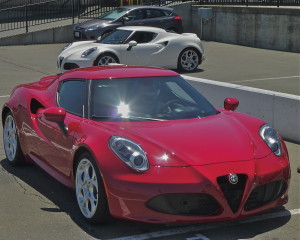
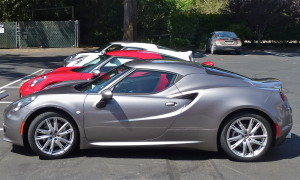
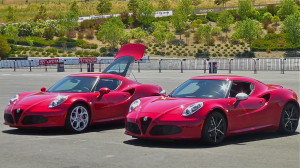
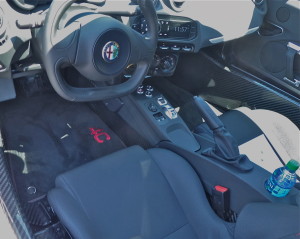
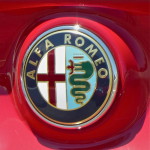
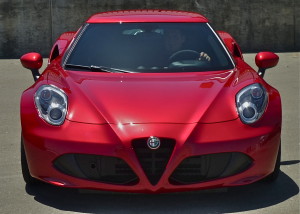
 John Gilbert is a lifetime Minnesotan and career journalist, specializing in cars and sports during and since spending 30 years at the Minneapolis Tribune, now the Star Tribune. More recently, he has continued translating the high-tech world of autos and sharing his passionate insights as a freelance writer/photographer/broadcaster. A member of the prestigious North American Car and Truck of the Year jury since 1993. John can be heard Monday-Friday from 9-11am on 610 KDAL(www.kdal610.com) on the "John Gilbert Show," and writes a column in the Duluth Reader.
John Gilbert is a lifetime Minnesotan and career journalist, specializing in cars and sports during and since spending 30 years at the Minneapolis Tribune, now the Star Tribune. More recently, he has continued translating the high-tech world of autos and sharing his passionate insights as a freelance writer/photographer/broadcaster. A member of the prestigious North American Car and Truck of the Year jury since 1993. John can be heard Monday-Friday from 9-11am on 610 KDAL(www.kdal610.com) on the "John Gilbert Show," and writes a column in the Duluth Reader.